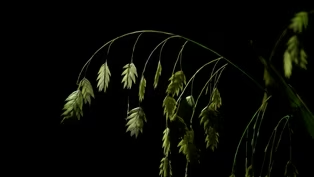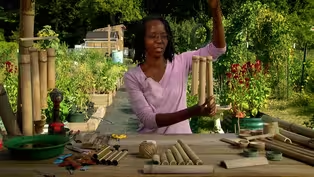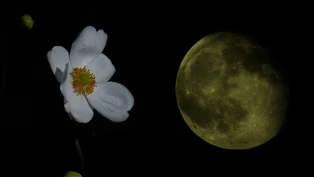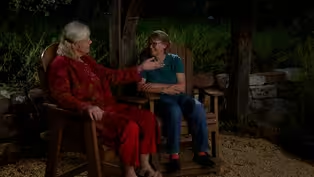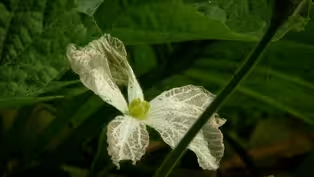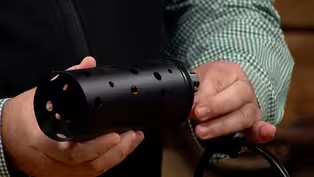Virginia Home Grown
Traditional Moon Garden Plants
Clip: Season 25 Episode 7 | 6m 23sVideo has Closed Captions
Discover the characteristics of plants for night time gardens
Earl Gary from YME Landscape visits with Peggy Singlemann to share an array of plants typically found in traditional moon gardens. Featured on VHG episode 2507, September 2025.
Problems playing video? | Closed Captioning Feedback
Problems playing video? | Closed Captioning Feedback
Virginia Home Grown is a local public television program presented by VPM
Virginia Home Grown
Traditional Moon Garden Plants
Clip: Season 25 Episode 7 | 6m 23sVideo has Closed Captions
Earl Gary from YME Landscape visits with Peggy Singlemann to share an array of plants typically found in traditional moon gardens. Featured on VHG episode 2507, September 2025.
Problems playing video? | Closed Captioning Feedback
How to Watch Virginia Home Grown
Virginia Home Grown is available to stream on pbs.org and the free PBS App, available on iPhone, Apple TV, Android TV, Android smartphones, Amazon Fire TV, Amazon Fire Tablet, Roku, Samsung Smart TV, and Vizio.
Providing Support for PBS.org
Learn Moreabout PBS online sponsorshipWell, Earl, I love seeing a table full of flowers, particularly those that glow in the moonlight.
But you know, we've got so many attributes on this table.
So share with me, what are some of those attributes for moon gardens?
>>Yeah, Peggy, how you doing?
>>I'm doing great.
>>So the moon gardens definitely, you're looking for white and light type plants, and definitely you want plants with fragrance and flowers that bloom at night.
>>Definitely.
Well, what are some of your favorite moon garden plants?
>>So, my favorite is the hibiscus.
This came outta my garden.
Technically, I think with the weather changing, like most of my leaves, it fell off, when it kind of got cold.
But then it started warming up.
And then this one just bloomed last night, so it was just perfect to bring this in today.
>>Perfect timing.
>>So look how big the flower is, it's white and bright and it's definitely an attractor.
>>Yes.
An excellent focal point for a moon garden.
>>Oh yeah.
>>Yes.
>>So another one of my favorite plants is this gardenia.
It's very fragrant, gardenias don't like to be in direct sunlight, so trying to find somewhere that's kind of close to the house or right up against the house that doesn't have full sunlight throughout the day.
But you get these beautiful plants that, they flower, this is the non bloom bulb.
But these things are great, and they smell so good.
>>And the pollinators are just so attracted to them.
>>Oh yeah, 100%.
>>Yes.
Absolutely.
But magnolias are another one, those are some of my favorite.
You've got these two.
>>So I got two different types of magnolias.
Of course, magnolia's a tree, flower and tree.
>>Right.
>>But yeah, they're very, very showy, and very, very bright.
You can see 'em from a great distance.
And these things grow extremely tall.
So it looks very nice.
>>Yes.
And both of these are native, we've got our swamp magnolia, as well as our grande flora.
>>Oh yeah.
>>Southern magnolia.
>>These are very nice.
>>Very good ones.
>>Tree flowers.
>>Yes.
Another native one.
What do you have over there?
>>This is a dogwood, so it's in kind of two different stages here.
But you know, these are the seeds, I guess they start blooming from this.
And a little later in the day, dogwood's bloom morely in the spring.
So it's late in the season, but I tried to bring what I could.
These are the berries on this one.
And these are- >>Buds for next year.
>>Buds for next year.
100%, yeah.
>>Again, wonderful.
We have to think of the spring as well as the summer and the fall for our moon gardens.
>>Right.
So this is a- >>I say the plant most people love to hate.
>>Oh, yeah, yeah, these yuccas.
So I couldn't, they're not in bloom right now, so I couldn't get a flower to show.
But definitely, I definitely like these yuccas.
They look really good.
Like I said, you got variegated colors in the middle of it.
And they give a real tall nice, and they got these little flowers that kind of fall, kind of look like bell shape, so it's really nice.
>>Yeah.
Color guard is my favorite cultivar.
I like the light pink in there.
>>Oh yeah.
>>With the yellow and the green.
>>Oh, yeah.
>>And it looks really sharp in the winter, but it lights up at night.
So we got one more shrub, and then we'll see if we can talk about a few of these perennials.
>>Oh yeah, this is the vibranium.
So these, they got really small flowers, but once they all bloom, it just looks like a huge, almost like a hibiscus, but it's just a huge, big show, you know?
>>Yes.
>>That kind of comes out.
So these are really, and this one's kind of, kind of blooming again, I guess again, from the temperature, they kind of coming out a little bit.
>>Exactly.
They kind >>Of start off a little brown, but then they end up changing colors.
>>Yeah.
And actually, you're right.
We had that period of dryness, the period of rain, and some of our plants are starting to rebloom that normally wouldn't be re blooming this time of year.
So we get the little extra show.
I agree with that.
But one people don't really think about is here, our tiarella, our native, our coral bells.
>>Yeah.
So you switch over to your perennial.
So yeah, this is a Tiarella.
And they have these pink, these pink white type flowers that grow off the top.
And now of course these are green.
This is a green.
So the heuchera kind of, it's in the heuchera family.
So there's some heucheras are burgundy, and then of course this green one.
So the tiarellas is the pink, they got nice, really, really kinda like frilly type flowers, that grow soft, really flowers that grow.
So I, you know, I love a lot of these.
I I plant a lot of these.
>>Yeah.
I enjoy them myself.
What's another favorite of yours?
Do you like those garden phlox?
This is Peggy's favorite.
>>I like phlox.
Right?
I got a lotta phlox in my garden too.
And they grow really fast in the spring.
In the first part of the spring, they kind of spread, especially if you get like spreading phlox and they just grow and they just take over that space.
And they just kind of really good ground cover.
So I got a lot of different color phlox but of course, moon gardens with the white- >>something that's very light.
>>Or very light pink.
>>Right.
Light pink.
Yeah.
>>But not the darker colors.
.
Not the darker colors, no.
>>And this is David.
So it's resistant to mildew.
You could choose different varieties that don't get the mildew, and it makes your garden look a little prettier too.
>>I'm learning something.
>>The other thing about phlox though, is that the fragrance, we were talking about fragrance.
And we were talking about color.
This hits both of 'em, like the gardenia.
>>Yes.
Mm-hmm.
>>Yeah.
Wonderful.
Well, here's one that most people don't know about.
It's veronicastrum.
And this is a fun one.
I'm gonna ask you to put that over there.
I'm running outta room over here.
>>I see, yeah.
>>You brought this one in.
This is a fun plant too.
Culver's root.
Not very common.
>>No, it's not really common.
It's not in bloom yet, but it kind of blooms like a spiny, really light purplish flower.
But it's pretty, it's very pretty.
It's really kind of spurs off.
But like I said, it's late in the season now, but technically, it is a good plant.
I plant a few of these a lot too.
And this is a perfect moon garden plant, especially for ground cover.
And it takes up space.
And it multiplies very well.
>>It does.
It really does.
It's a good one.
But people also kind of, we'll do our last one here, is some of, everybody's favorite, is the snowdrops.
>>Oh yeah, >>Sorry.
Sundrops, excuse me.
>>Sundrops.
Yeah.
So it's primrose, I think.
>>Primrose?
Yeah.
>>So these are really nice.
I think I got another one.
It's got a stalk on it that's almost about to bloom.
But again, if you can see, it's like a really tall stalk.
And the blooms kind of start at to top and just kinda roll down in a bell shape.
So, yeah, late in the season again.
So you probably gonna have to wait until the spring to get a full bloom.
But they look, they are very, you see the leaves got a burgundy color, so they got other colors in it, but they do bloom white.
>>[Peggy[ And it's nice to think About spring, summer, and fall.
>>Oh yeah.
>>For that garden.
>>Yes.
>>Well, Earl, thank you.
Thank you so much for coming in and sharing us some of your favorite plants for moon gardens.
We greatly appreciate it.
>>Oh, thank you.
Clippings: The Nighttime Garden
Video has Closed Captions
Clip: S25 Ep7 | 26m 46s | Explore the garden after dark! (26m 46s)
Video has Closed Captions
Clip: S25 Ep7 | 3m 35s | Calming sounds benefit your garden day or night (3m 35s)
Video has Closed Captions
Clip: S25 Ep7 | 8m 8s | Learn why a day and night cycle is just as important to plants as it is to us (8m 8s)
Video has Closed Captions
Clip: S25 Ep7 | 7m 36s | Visit a garden full of native plants designed to be enjoyed at night (7m 36s)
Night Pollination in the Vegetable Garden
Video has Closed Captions
Clip: S25 Ep7 | 2m 43s | Pollination occurs around the clock in our gardens (2m 43s)
Responsible Landscape Lighting
Video has Closed Captions
Clip: S25 Ep7 | 6m 18s | Learn how to reduce glare and enhance your garden lighting design (6m 18s)
Providing Support for PBS.org
Learn Moreabout PBS online sponsorship

- Home and How To

Hit the road in a classic car for a tour through Great Britain with two antiques experts.












Support for PBS provided by:
Virginia Home Grown is a local public television program presented by VPM
